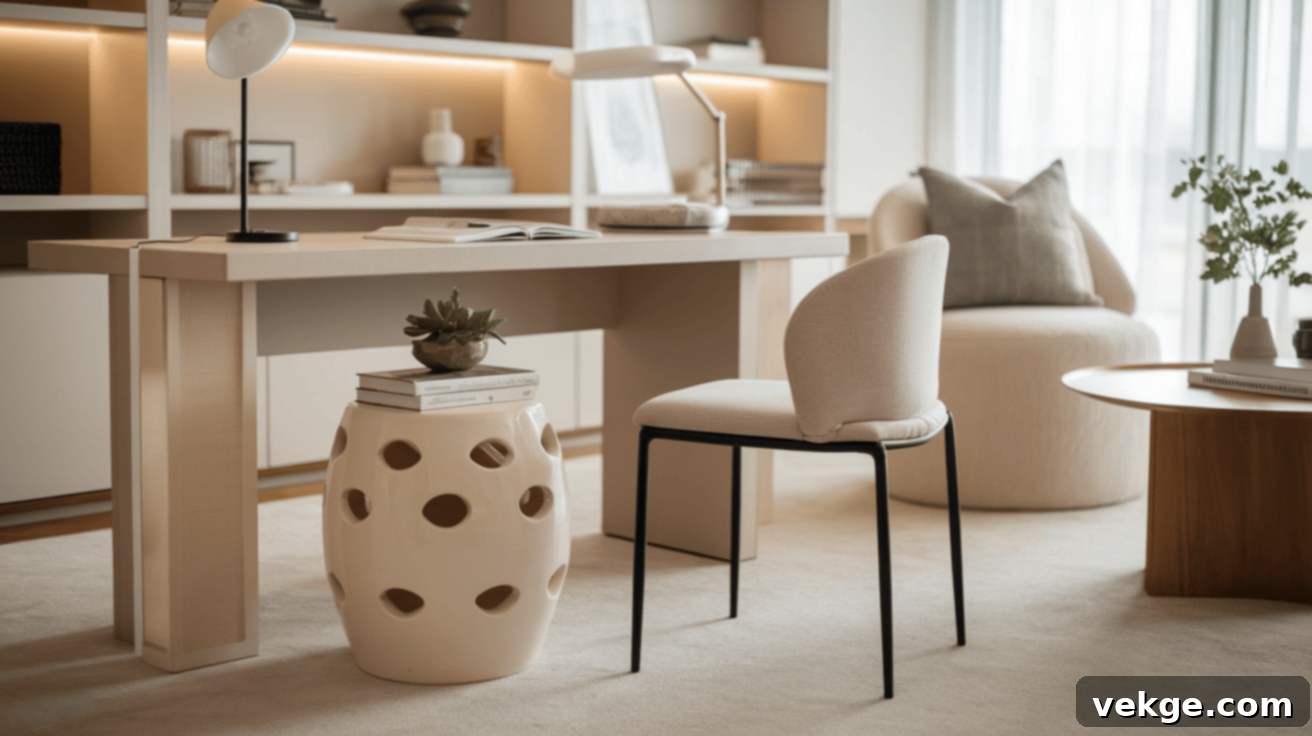Unlock Your Home’s Potential: The Ultimate Guide to Decorating with Versatile Garden Stools
Are you struggling with a home that feels cramped, cluttered, or simply lacking that special touch of style? It’s a common challenge, especially in smaller living areas, to create spaces that are both functional and aesthetically pleasing. But what if there was a simple, yet incredibly versatile piece of furniture that could unlock your home’s potential, adding both utility and charm without overwhelming your existing layout? Enter the humble garden stool – a design secret weapon you might not have considered.
This compact, multi-functional piece of furniture has the power to transform your interior and exterior spaces in ways you never imagined. Far from being confined to just gardens, these stools have evolved into essential elements of modern home decor, offering solutions for everything from impromptu seating to stylish display surfaces.
In this comprehensive guide, we’ll delve into the fascinating world of garden stools. We’ll explore their rich history, uncover creative ways to seamlessly integrate them into every room of your home, and provide expert advice on selecting the perfect material to match your aesthetic. Plus, for the hands-on homeowner, we’ll share exciting DIY ideas to personalize your stools and essential maintenance tips to ensure they remain beautiful for years to come. Get ready to maximize your space and infuse every corner with effortless style!
What is a Garden Stool? More Than Just a Seat
At its core, a garden stool is a small, highly versatile piece of furniture renowned for its blend of practicality and distinctive style. While their name suggests an outdoor purpose, these delightful stools have gracefully transitioned into indoor living, becoming particularly cherished in homes where space optimization is key. Their compact footprint makes them incredibly adaptable, fitting snugly into tight areas like entryways, bathrooms, or even serving as clever extra seating in a bustling living room.
The origins of the garden stool can be traced back to ancient China, where they were traditionally crafted from ceramic and used in gardens as portable seats or small tables. These early versions were often exquisitely decorated with intricate patterns, symbolic motifs, and vibrant glazes, reflecting their status as objects of both utility and art. Over centuries, their design evolved, incorporating various materials and styles, eventually making their way into Western homes where their unique charm was quickly appreciated.
Today, garden stools are available in an astonishing array of materials, from the timeless elegance of ceramic and the rustic warmth of wood, to the sleek modernity of metal and the organic texture of rattan. This diversity means there’s a garden stool to complement virtually any decor theme – be it bohemian, minimalist, traditional, or contemporary. Many designs feature vibrant colors, unique patterns, or sculptural forms, allowing them to serve as a captivating pop of style in any setting. Their lightweight nature further enhances their functionality, making them effortlessly movable – transform it from a chic side table to a vibrant plant stand or convenient extra seating for guests in a matter of seconds. Ultimately, a garden stool is more than just furniture; it’s a simple yet highly effective tool to elevate your home’s aesthetic while intelligently maximizing every inch of available space.
Decorating with Garden Stools: Creative Styling for Every Room
Garden stools are truly a decorator’s dream, offering an unparalleled blend of functionality and aesthetic appeal. These versatile pieces can act as dynamic decorative accents, practical seating, or even clever storage solutions, effortlessly enhancing your home’s look while saving precious space. Discover how to integrate these design chameleons into various areas of your home:
1. As a Side Table or Chic Accent Piece in Living Areas
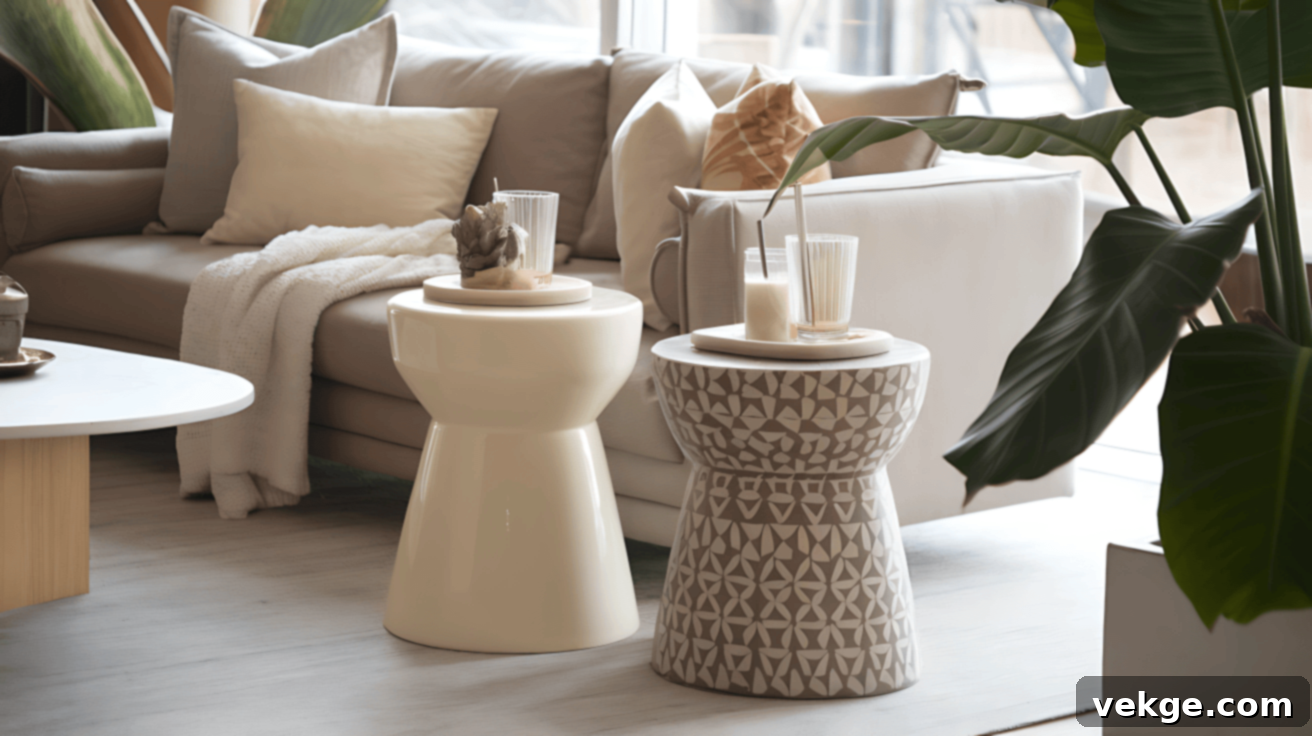
In the living room, garden stools shine as ideal side tables nestled beside sofas, armchairs, or even chaise lounges. They provide a perfectly sized surface for drinks, books, remote controls, or a delicate teacup, all while maintaining a visual lightness that prevents the space from feeling heavy or overcrowded. Their compact size makes them superior to bulkier end tables, especially in smaller apartments or open-plan living areas.
Beyond utility, use them as sculptural accent pieces in empty corners, perhaps topped with a small indoor plant or a framed photo, to add personality. They can also effectively break up large furniture groupings, adding an interesting focal point. Their inherent sculptural quality and easy portability make them invaluable for entertaining; simply pull one up for an extra surface for appetizers or a temporary seat during social gatherings. Consider pairing two identical stools for a symmetrical look or mixing different materials and finishes for an eclectic vibe.
2. As a Stylish Nightstand or Decorative Element in Bedrooms
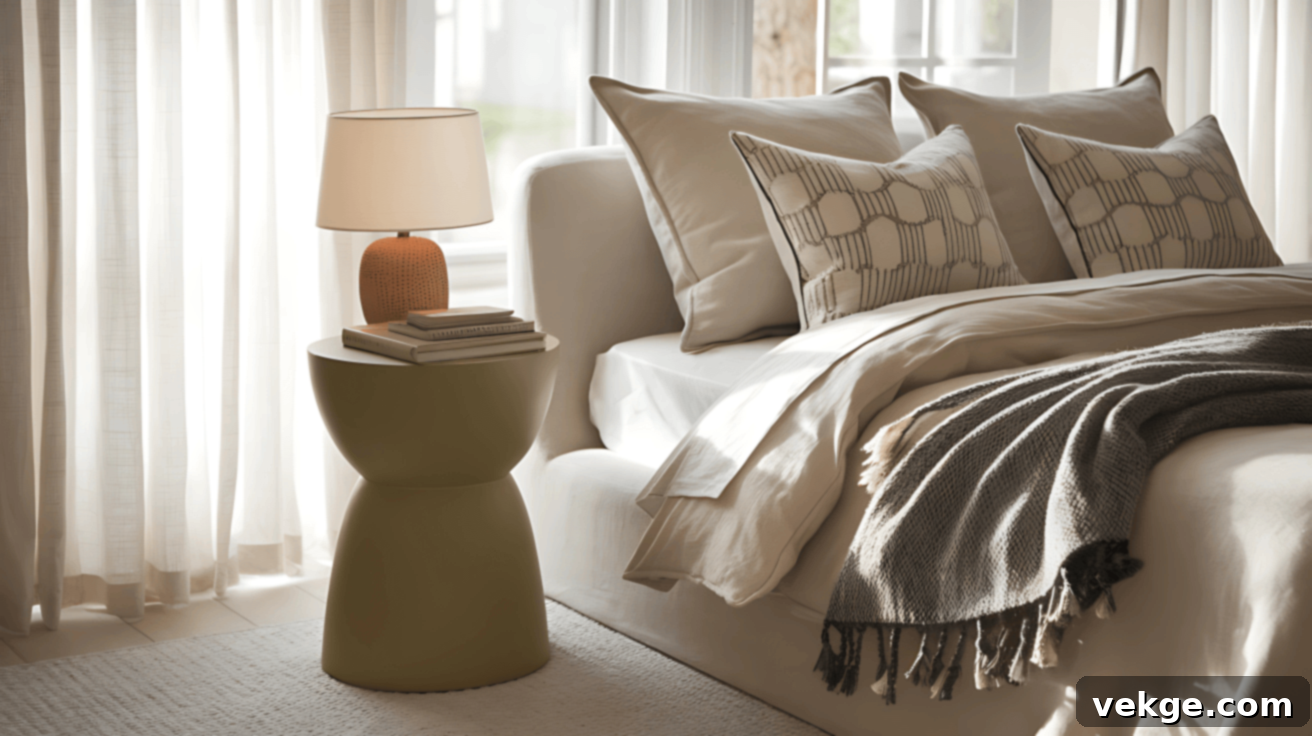
For smaller bedrooms where traditional nightstands can feel cumbersome, garden stools offer an exceptional alternative. Their slender profile fits perfectly next to the bed, providing just the right height for a reading lamp, your current book, an alarm clock, or a glass of water. A ceramic stool with a glossy finish can add a sophisticated touch, while a wooden or rattan option brings warmth and texture to your bedside.
But their utility extends beyond the bedside. Position a garden stool at the foot of your bed to artfully hold extra throws and decorative pillows, enhancing the room’s layered look. In neglected corners, they transform into charming plant stands, elevating greenery and introducing a natural element, or serve as display surfaces for treasured decorative objects, adding character and visual interest to the room’s quieter zones.
3. Practical and Stylish Options for Bathrooms

Bathrooms, often overlooked in terms of decorative accents, can greatly benefit from the addition of a garden stool. Here, they provide invaluable waterproof seating – perfect for a moment of relaxation during a bath or for setting down items while getting ready. They also serve as smart storage solutions for neatly stacked towels, an array of toiletries, or even a serene potted plant, instantly elevating the space.
Their inherent moisture-resistant construction, especially those made from ceramic or treated metal, makes them an ideal choice for the damp environment of a bathroom. They contribute to a luxurious, spa-like setting, offering both high-end appeal and practical convenience for daily routines or indulgent self-care moments. Imagine a sleek metallic stool holding bath salts next to a tub, or a vibrant ceramic one adding a pop of color to an otherwise neutral vanity area.
4. A Welcoming Decorative Touch by the Door
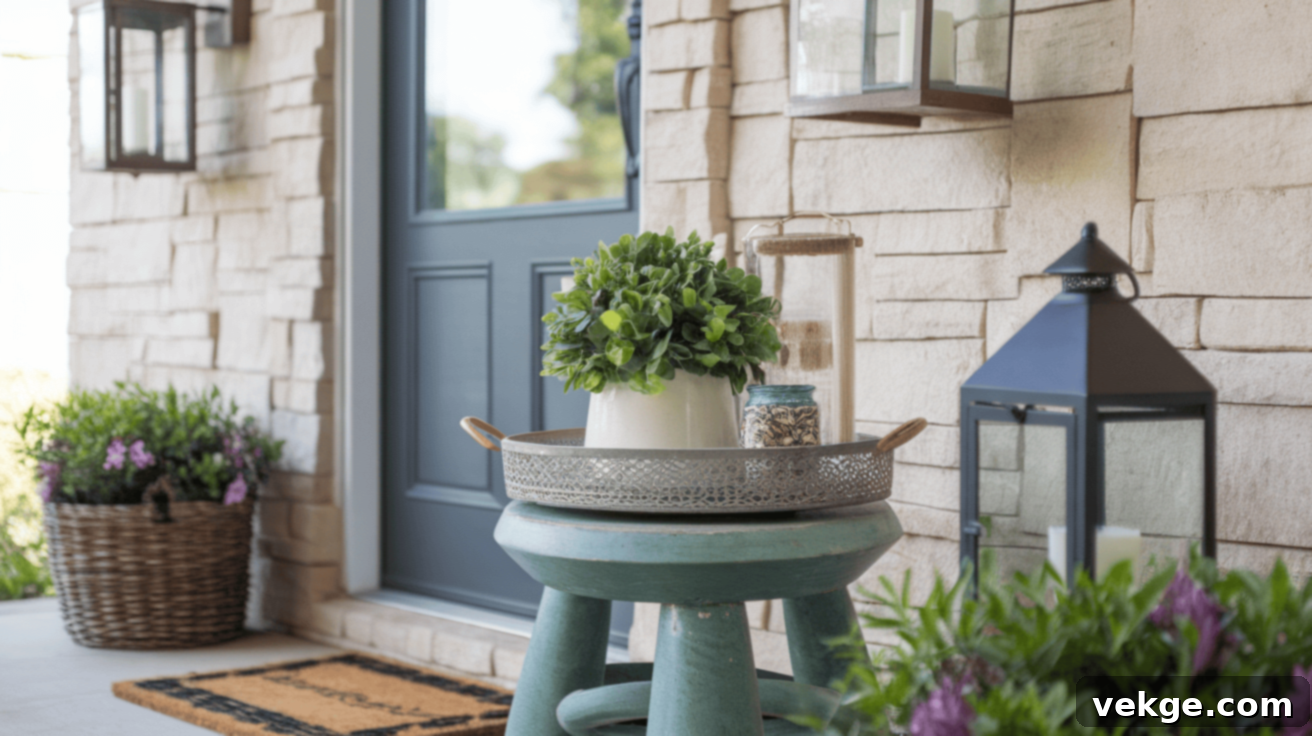
First impressions matter, and garden stools can make remarkable statements in entryways and hallways. They provide convenient seating for the ritual of putting on or taking off shoes, making daily comings and goings much smoother. Beyond their practical use, they serve as powerful decorative anchors, drawing the eye and setting the tone for your home’s style right from the threshold.
Use them to beautifully display seasonal flowers in a chic vase, offer a dedicated spot for keys and mail, or create charming welcoming vignettes in even the narrowest hallways and small foyers. A brightly colored stool can inject energy into a muted space, while a textured rattan stool can add warmth and an organic feel, making every entrance a little more inviting and organized.
5. Enhancing Outdoor Spaces and Garden Setups
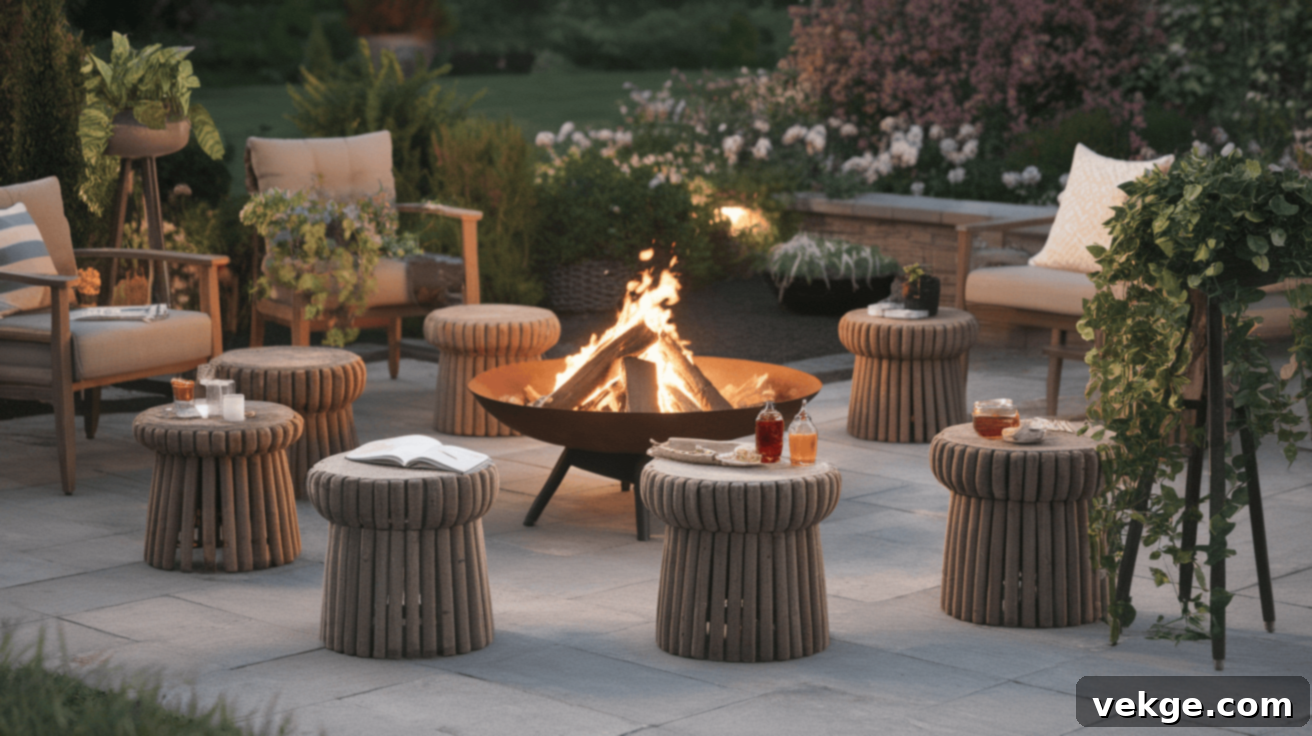
Naturally, garden stools excel in their namesake environment. In outdoor settings, they provide wonderfully versatile seating options around a cozy fire pit for evening gatherings, serve as convenient side tables for al fresco dining or poolside lounging, or function as elegant plant stands, adding vertical interest and varied displays to your garden or patio. Their ability to elevate potted plants can create dynamic layers and visual depth in your green spaces.
Their typically weather-resistant properties and impressive mobility make them perfect for patios, decks, balconies, and even within the garden itself. You can easily rearrange them for different occasions – a large family BBQ, a quiet morning coffee, or a lively evening party. Choose materials like ceramic, treated metal, or durable synthetic rattan for maximum longevity and minimal maintenance in the face of the elements, allowing them to truly integrate into and enhance your outdoor living experience.
Choosing the Right Garden Stool for Your Space: A Buyer’s Guide
Selecting the perfect garden stool for your home involves a thoughtful consideration of both your practical needs and the overarching aesthetic of your existing decor. With such a vast array of options available, making an informed choice ensures your new stool will be a cherished and functional addition. Here’s a deeper dive into the factors to consider:
Key Considerations Before You Buy
- Indoor or Outdoor Use: This is paramount. While many garden stools are versatile, specific materials are better suited for sustained outdoor exposure. Ceramic and treated metal often offer superior weather resistance, essential for resisting rain, sun, and temperature fluctuations. Untreated wood or certain textiles are best kept indoors or in covered outdoor areas.
- Complement Your Current Decor: The stool should blend seamlessly or provide a deliberate, complementary contrast to your existing furniture and color palette. Consider its style, color, and texture.
- Functionality: What primary role will it play? Is it mainly for seating, a side table, a plant stand, or purely decorative? Some stools offer integrated storage, adding another layer of utility.
- Size and Scale: Measure your intended space to ensure the stool fits proportionally. A large stool in a tiny nook can feel overwhelming, while a too-small stool next to a large sofa might look insignificant. Consider its height relative to adjacent furniture if it’s meant to be a side table or nightstand.
- Maintenance Requirements: Natural materials like wood or unglazed rattan may require more specific care, such as regular oiling or protection from moisture, compared to ceramic or metal.
- Budget: Garden stools come at various price points. Ceramic and eco-friendly options can offer excellent value, balancing durability with design. Decide if you’re looking for a temporary accent or a long-term investment piece.
Material Matters: Style, Durability, and Care
The material of your garden stool dictates not only its durability and care requirements but also its overall aesthetic and the atmosphere it creates. Here’s a detailed breakdown of popular options:
| Material | Style & Decor Compatibility | Durability & Key Features | Best For | Care Requirements |
|---|---|---|---|---|
| Ceramic | Classic, graceful, often features traditional patterns, intricate glazes, or vibrant solid colors. Adaptable to traditional, transitional, eclectic, and even modern styles. | High weather resistance, chip-resistant, fade-resistant. Can be heavy and brittle if dropped. | Indoor/outdoor use, formal spaces, traditional decor, bathrooms, adding a pop of color or artistry. | Easy cleaning with mild soap and water. Occasional resealing recommended for unglazed finishes. Protect from freezing temperatures to prevent cracking. |
| Metal (Iron, Aluminum, Steel) | Modern, industrial, sleek lines, minimalist. Available in various finishes like polished, matte, distressed, or painted. Ideal for contemporary, urban, or industrial aesthetics. | Very High durability. Rust-resistant when properly treated (powder-coated, galvanized). Lightweight (aluminum) or heavy (iron) depending on type. | Contemporary spaces, outdoor patios, minimalist decor, high-traffic areas. Can complement industrial-chic interiors. | Simple wipe-down with a damp cloth. Regular inspection for rust; touch up any chipped paint. Apply rust-preventative treatment annually for outdoor pieces. |
| Wood (Teak, Acacia, Cedar) | Natural, warm, organic textures, rustic, Scandinavian, or bohemian. Each wood type offers unique grain patterns and color variations. | Medium to High durability, requires maintenance. Naturally resistant to pests and moisture (teak, cedar), but all wood benefits from protection. Can fade or crack if neglected. | Bohemian spaces, natural decor, covered outdoor areas (porches, pergolas), adding warmth and an earthy feel to interiors. | Regular dusting, use appropriate wood cleaner. Condition with wood oil every 6-12 months. Protect from direct moisture and prolonged sun exposure. |
| Rattan / Woven Materials | Casual, textured, woven patterns, coastal, bohemian, relaxed, natural. Adds an organic, airy feel. | Medium durability – best for covered areas or indoors. Can become brittle or discolored with direct sun and heavy rain. | Coastal decor, casual spaces, covered patios, sunrooms, bedrooms, adding warmth and a natural texture. | Dusting with a soft brush or vacuum. Humidity control is important to prevent drying out or mold. Wipe spills immediately. |
| Eco-Friendly / Sustainable Options | Varied – recycled plastics, bamboo, reclaimed wood, cork. Styles range from modern minimalist to rustic, depending on the material. | Varies significantly by specific material. Often designed for durability and longevity, supporting sustainable living. | Environmentally conscious spaces, modern eco-homes, adding a unique story and texture. | Depends on the specific material (e.g., bamboo may need occasional oiling, recycled plastics are usually low maintenance). |
DIY & Upcycling Garden Stools: Personalize Your Space
Embracing DIY and upcycling is a wonderfully rewarding and creative way to breathe new life into old items or craft something truly unique from scratch. Not only does it allow you to personalize your home decor, but it also promotes sustainability by reducing waste. Here, we’ll guide you through turning everyday objects or basic materials into stylish and functional garden stools, whether you’re building from scratch or giving an old piece a fresh look.
Materials Needed for a DIY Wooden Stool Project
Before you begin your creative endeavor, gather these essential supplies to ensure a smooth and successful project:
- Wood Panels: Pine boards (for gluing) or 18mm thickness plywood.
- Wood Glue: Strong adhesive for securing panels.
- Sandpaper: Various grits (e.g., 120, 180, 220) for smoothing surfaces.
- Primer: Essential for proper paint adhesion and a durable finish.
- Paint: Your desired color and finish (see recommendations below).
- Brushes/Rollers: For applying paint and sealant.
- Sealant/Protective Finish: For durability and weather resistance (e.g., Osmo oil, polyurethane).
- Cleaning Supplies: Rags, mild soap, and water for preparation.
- Woodworking Tools: Mitre saw, table saw, bandsaw or jigsaw, drill (with Forstner bit), clamps, pocket hole jig (optional but recommended), double-sided tape.
Step-by-Step Guide to Building a Wooden Garden Stool
Follow these detailed steps to construct your very own custom garden stool:
Step 1: Prepare and Glue the Panels
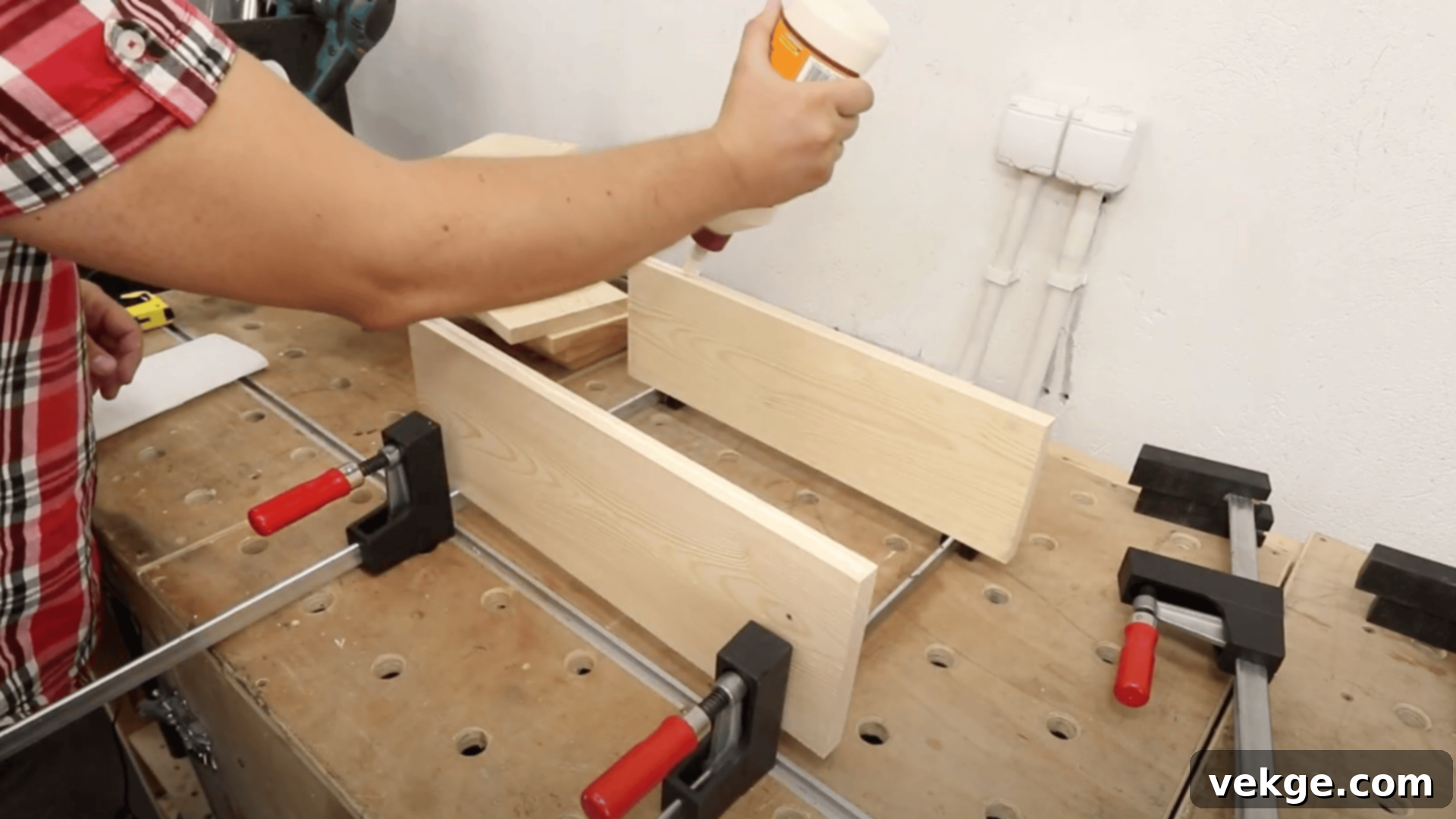
Begin by joining your wood panels to create larger, sturdier sections for the stool’s components. If using pine boards, apply a generous amount of wood glue along the edges, then press them firmly together. Use wood clamps to hold the glued panels securely while the adhesive dries completely, typically overnight. For added strength and precision, consider using pocket holes, dowels, or biscuits to reinforce the joints, especially if the stool will bear significant weight. If opting for plywood, ensure it’s of at least 18mm thickness for adequate stability.
Step 2: Sand and Cut the Panels to Size
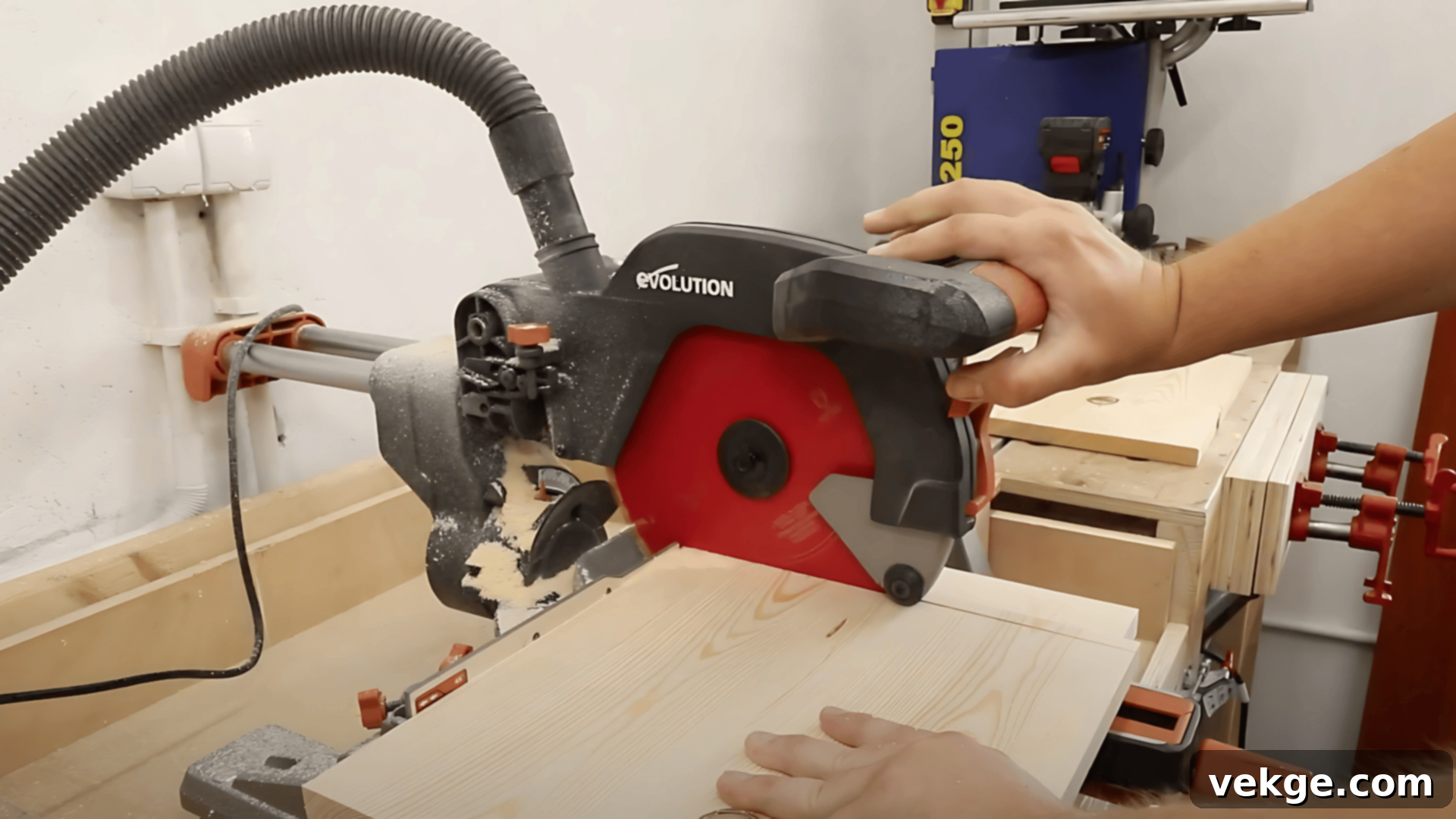
Once the glue has fully cured and the panels are solid, carefully remove them from the clamps. Lightly sand all surfaces with a medium-grit sandpaper (e.g., 120-grit) to smooth out any rough edges, glue squeeze-out, or imperfections. Next, precisely cut the panels to their correct lengths using a mitre saw. Then, trim them to the exact width using a table saw, ensuring all pieces are uniform and ready for assembly. Accurate cuts are crucial for a stable and aesthetically pleasing stool.
Step 3: Shape the Stool Legs for Stability and Style
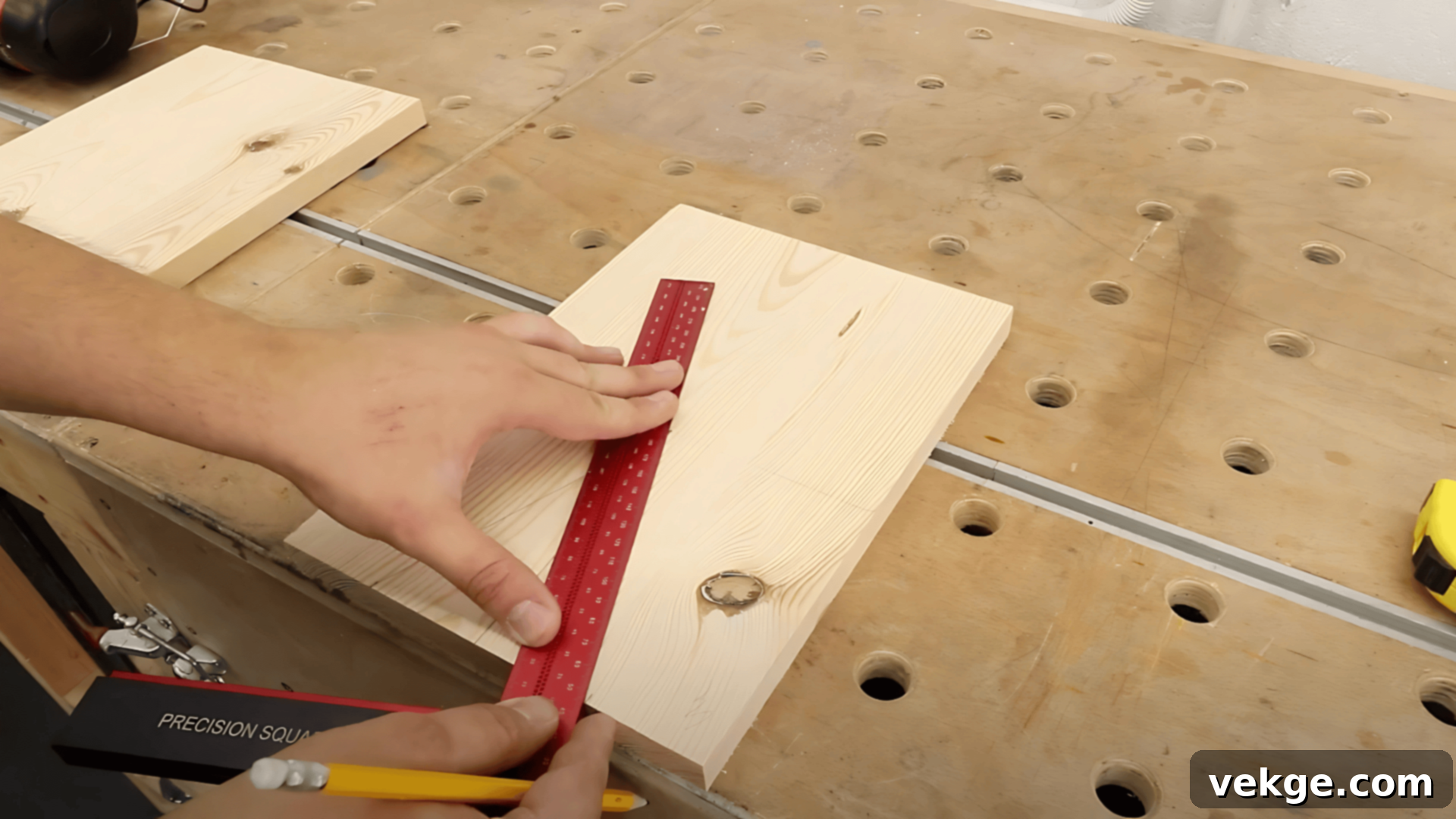
To create unique and stable legs, draw your desired triangle shape onto one of the cut wood panels. For consistency and precision, it’s highly recommended to use double-sided tape to temporarily glue two leg pieces together. This allows you to cut both parts simultaneously using a bandsaw or a jigsaw, ensuring they are perfectly identical. This step is key for achieving uniform legs that will provide excellent balance and a cohesive look for your finished stool.
Step 4: Add a Handle and Refine the Seat Design
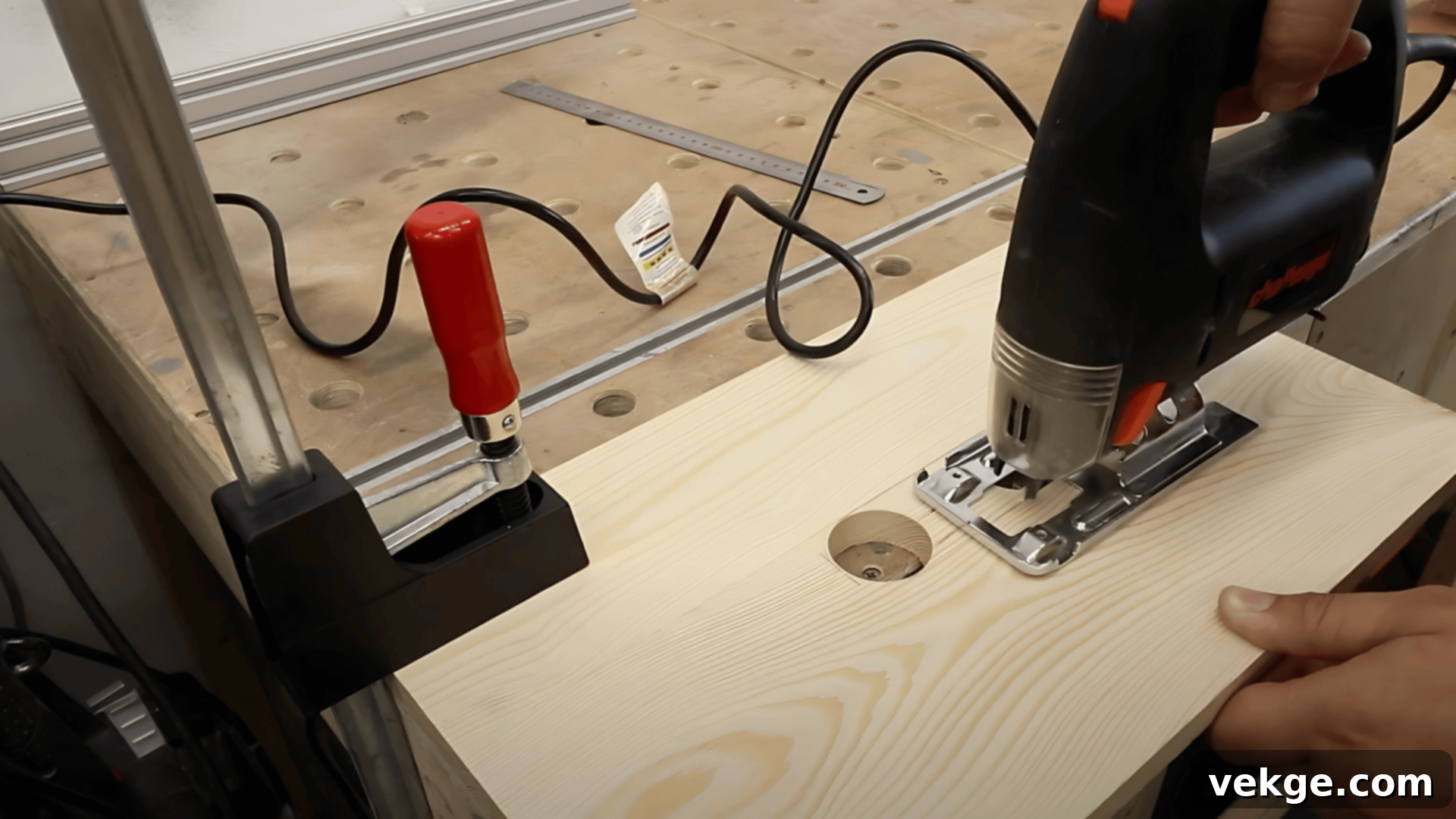
For added portability and charm, incorporate a handle into the stool’s design. Use a Forstner bit to drill two precisely spaced holes on the top panel (which will be the seat). Then, with a jigsaw, carefully connect these two holes to create a clean, ergonomic handle opening. Next, focus on the seat’s aesthetics: gently cut off the sharp corners to round them, then meticulously sand these rounded edges for a smoother, more appealing, and comfortable finish. This step adds both functionality and a refined touch.
Step 5: Assemble and Finish Your Custom Stool
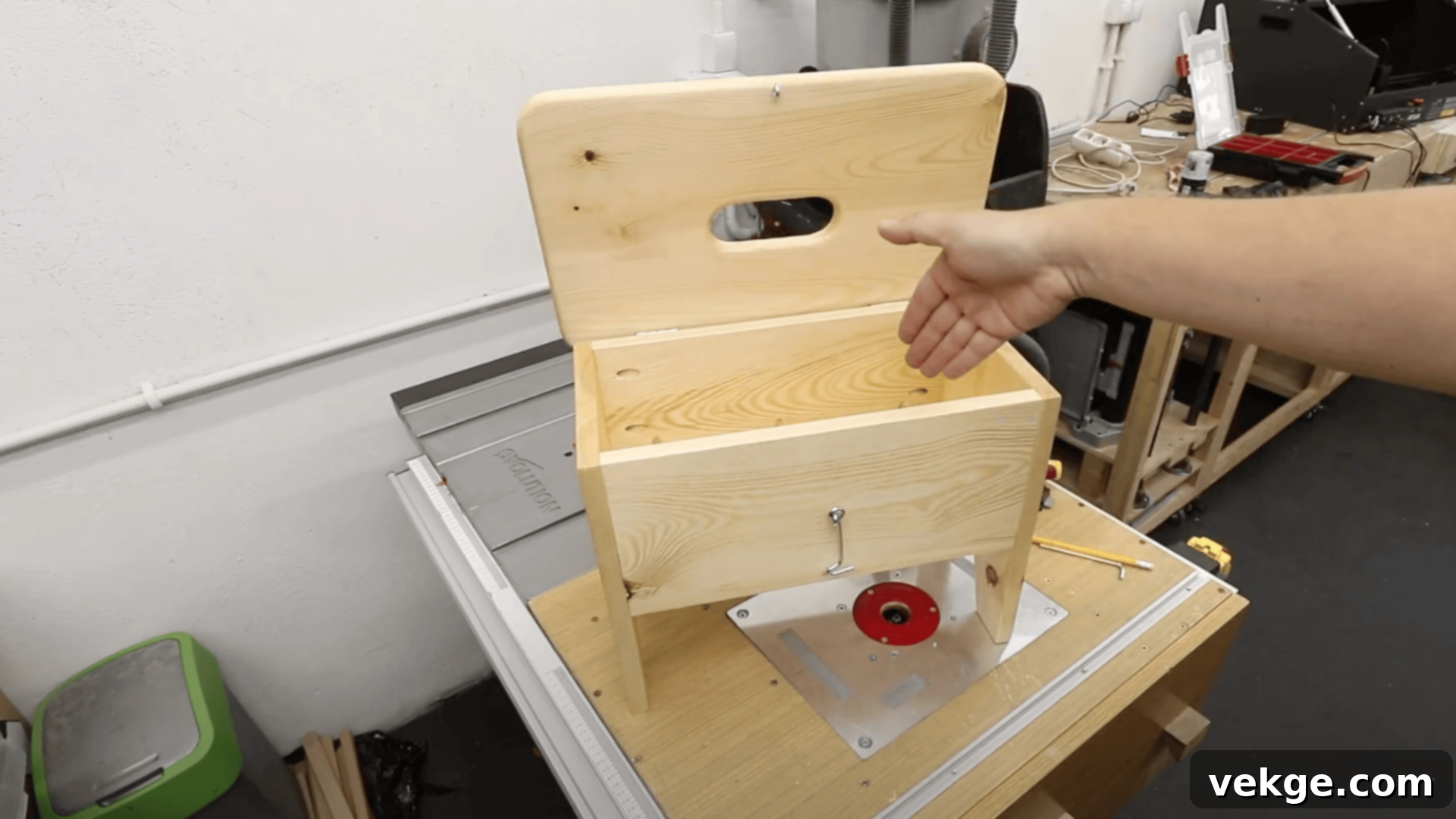
Now, it’s time for assembly. Utilize pocket holes for strong, discreet joints, securing all the stool’s parts together. Apply wood glue to all mating surfaces before driving screws for extra strength and longevity. Once the stool is fully assembled, apply a protective finish like Osmo oil, which penetrates the wood to protect it while enhancing its natural beauty. For a truly personal touch, consider adding a laser engraving to the seat or legs. If you envision your stool having secret storage, you could ingeniously add hinges to the seat, transforming it into a hidden compartment for small items.
Painting and Refurbishing Your Existing Garden Stool
If you already own a garden stool that’s seen better days or simply doesn’t match your current decor, a fresh coat of paint is a fantastic solution. Give your garden stool a stylish new lease on life with these easy painting steps and creative techniques:
- Step 1: Clean Thoroughly: Begin by thoroughly cleaning the stool with mild soap and water to remove any dirt, grime, or old residue. Ensure it is completely dry before proceeding.
- Step 2: Lightly Sand: Gently sand the entire surface with fine-grit sandpaper (e.g., 220-grit). This creates a slightly rough texture, allowing the primer and paint to adhere much better, preventing chipping and peeling.
- Step 3: Apply Primer: Apply a high-quality primer suitable for your stool’s material (ceramic, metal, or wood). Primer helps to seal the surface, blocks old colors from bleeding through, and provides a uniform base for your chosen paint.
- Step 4: Paint with Style: Choose and apply your desired paint finish. For a rustic, farmhouse look, opt for chalk paint. For a vibrant, modern design, a high-gloss enamel works wonders. Experiment with fun techniques like stenciling, color blocking, or a distressed finish to create a truly unique piece.
- Step 5: Seal for Durability: Once the paint is completely dry, apply an appropriate topcoat or sealant. For outdoor stools, a weather-resistant polyurethane or clear coat is essential to protect against the elements. For indoor pieces, a clear varnish will provide durability and a lasting finish.
Paint Recommendations for Various Styles
Here are some top paint recommendations to help you achieve specific styles and finishes for your garden stools, transforming them into bespoke decor elements:
| Brand | Color Finish/Effect | Style/Theme |
|---|---|---|
| Cuprinol Garden Shades | Soft Matt, Pastels, Wood Stain Effect | Cottage, Farmhouse, Shabby Chic, Traditional Garden |
| Rust-Oleum Garden Paint | Smooth Matt, Vibrant Brights, Satin | Modern, Pop Art, Contemporary, Bold Accents |
| Craig & Rose Artisan Effect | Stone, Concrete, Textured Finish | Rustic, Organic, Industrial, Earthy, Mediterranean |
| Ronseal Garden Paint | Matte, Natural Greens, Earth Tones | Botanical, Nature-inspired, Woodland, Eco-friendly |
| Benjamin Moore | High Gloss, Deep Navy, Rich Jewel Tones | Urban Chic, Contemporary, Sophisticated, Classic Elegance |
| Sadolin Superdec Satin | Satin, Opaque, Custom Colors for Wood | Classic, Transitional, Protected Wood Finish, Scandinavian |
| Modern Masters | Metallic (Gold, Bronze, Silver), Pearlescent | Glam, Luxe, Art Deco, Industrial Chic, Statement Piece |
Cleaning and Upkeep for Different Materials: Ensuring Longevity
To keep your garden stools looking pristine and extending their lifespan, regular care tailored to their specific material is essential. Neglecting proper maintenance can lead to fading, rust, or damage. Here’s how to effectively clean and maintain different types of garden stools:
- Ceramic/Porcelain: These are generally low-maintenance. Clean surfaces with a soft cloth dampened with mild soap and water. Avoid harsh abrasive cleaners or scouring pads, as these can scratch glossy finishes or damage intricate patterns. Always dry ceramic stools completely after cleaning to prevent water spots, especially in hard water areas. If your ceramic stool is unglazed, consider applying a ceramic sealant periodically to protect it from stains and moisture absorption.
- Metal (Iron, Aluminum, Steel): Wipe metal stools with a damp cloth and mild detergent. The most critical step is to dry them immediately and thoroughly to prevent rust formation, particularly for iron. For outdoor metal stools, inspect regularly for any chips in the paint or finish. Touch up these areas with rust-inhibiting paint. Applying a protective car wax or metal sealant seasonally can create an additional barrier against moisture and UV damage, significantly extending their life.
- Wood/Rattan: Natural materials require a bit more attention. Dust wood and rattan stools regularly with a soft cloth or a soft brush to prevent grime buildup in crevices. For deeper cleaning, use a wood-specific cleaner or a slightly damp cloth with mild soap, ensuring not to oversaturate the material. Wood stools benefit from conditioning with an appropriate wood oil (like teak oil or linseed oil) every 6-12 months to prevent drying, cracking, and to maintain their luster. Rattan, being a natural fiber, is susceptible to excessive moisture and direct sunlight; protect it from prolonged exposure to both. Regularly check for signs of mildew or pest infestation and address them promptly.
Practical Tips for Maintaining Your Garden Stools: A Holistic Approach
Beyond material-specific cleaning, a proactive approach to maintenance ensures your garden stools remain beautiful and functional for years. These general tips cover proper care, protection, and smart usage habits:
- Ensure Proper Ventilation: When painting or applying sealants, always work in well-ventilated areas to avoid inhaling fumes and to facilitate proper drying. This also applies to storing natural material stools like rattan, which need airflow to prevent mold.
- Allow Ample Drying Time: Patience is key. Always allow proper drying time between coats of primer, paint, and sealant. Rushing this step can lead to a less durable finish, peeling, and a compromised appearance.
- Test Finishes First: Before committing to a full repaint or new finish, test paint colors and sealants on an inconspicuous area of the stool, or on a scrap piece of the same material, to ensure you’re happy with the result.
- Seal Outdoor Pieces Properly: For any garden stool intended for outdoor use, a high-quality, weather-resistant topcoat or sealant is non-negotiable. This protects against UV rays, moisture, and temperature fluctuations, preventing fading, cracking, and rust.
- Consider Weight Capacity for Conversions: If you’re converting a stool for a new function (e.g., adding storage or using it for heavy plants), always consider its original and modified weight capacity to ensure safety and prevent damage.
- Protect Your Floors: Use felt pads or rubber stoppers on the bottom of indoor garden stools to prevent scratches on hardwood floors, tiles, or other delicate surfaces.
- Avoid Direct Sunlight & Heat: Prolonged exposure to direct sunlight can cause colors to fade and natural materials to dry out and crack. Similarly, excessive heat can damage finishes. Position stools thoughtfully or use window treatments to mitigate exposure.
- Use Coasters for Added Protection: When using your garden stool as a side table, always place coasters under drinks to prevent water rings, stains, or damage to the surface finish.
- Rotate Usage: If you have multiple garden stools or frequently use one for a specific purpose, try to rotate its usage or position. This helps to prevent uneven wear and tear, ensuring all sides age gracefully.
- Tighten Hardware Regularly: For stools with visible hardware (screws, bolts), periodically check and tighten them. This prevents wobbling and enhances the overall stability and safety of the piece.
- Address Minor Repairs Immediately: Don’t let small issues escalate. A minor chip, scratch, or loose joint should be addressed promptly to prevent further damage and maintain the stool’s integrity and appearance.
- Seasonal Storage for Harsh Weather: During extreme weather conditions (heavy snow, prolonged rain, intense heat), consider storing outdoor garden stools in covered areas like a shed, garage, or even indoors to protect them from the elements and extend their life significantly.
- Apply Weatherproof Sealants Annually: For outdoor wooden or metal stools, reapply weatherproof sealants or protective waxes annually, or as recommended by the product manufacturer, to maintain their protective barrier.
- Avoid Standing on Wet Surfaces: Especially for wooden stools, avoid prolonged contact with wet ground or standing water, as this can lead to water damage, rot, or swelling. Use risers if needed.
Conclusion: Redefine Your Space with the Power of Garden Stools
Throughout this guide, we’ve explored the incredible versatility and undeniable charm that garden stools bring to any living environment. From their ancient origins as humble garden seating to their modern role as sophisticated, multi-functional decor pieces, it’s clear that these compact marvels are a total game-changer for homeowners. They effortlessly offer extra seating, provide convenient side tables, and even double as clever storage solutions, all without demanding significant floor space.
Whether you reside in a bustling tiny apartment, a cozy suburban home, or a spacious house, I’ve observed firsthand how seamlessly these pieces integrate everywhere. They truly excel at filling those awkward empty corners, providing much-needed surfaces in tight spots, or offering impromptu seating when guests arrive, proving that a garden stool might just be the missing element you’ve been searching for to elevate your space.
Embrace the opportunity to get creative with your styling, mix and match materials, or embark on a fulfilling DIY project to craft a garden stool that perfectly reflects your personal aesthetic. The potential for enhancing your home’s functionality and injecting it with a fresh burst of style is immense.
Ready to upgrade your space and discover more innovative decorating ideas? Continue your journey by exploring other inspiring decorating blogs on our website!
